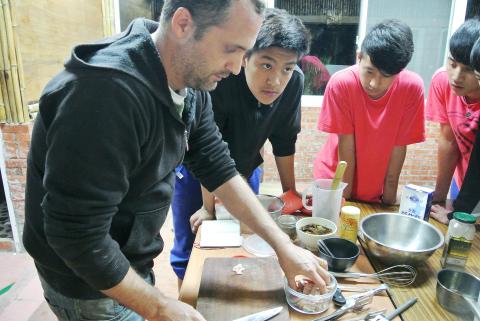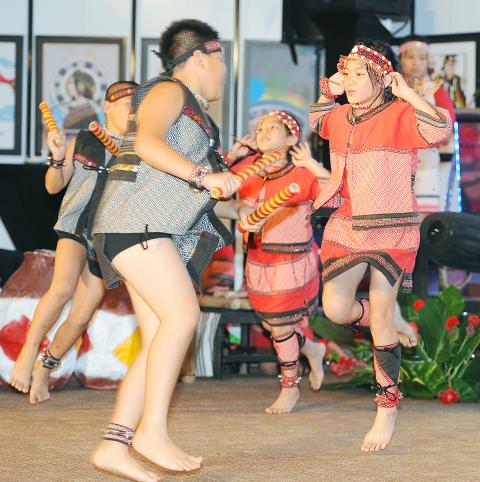French chef Guillaume Brissaud has stayed in Taiwan for eight years and married a Taiwanese woman. He sees Taiwan as his second home and runs a French restaurant in New Taipei City’s Sindian District. At the invitation of the Taiwan Fund for Children and Families, Brissaud visits Tranan Village in Wulai District every month to teach French cuisine to youngsters interested in cooking, by which he hopes that he can help disadvantaged youngsters living in remote areas to realize their dreams.
Lin Chih-yu, a social worker at the fund, said Brissaud used to be an English teacher, but last year he discussed with his wife about changing career paths by making use of the French cuisine that he had learned since childhood to open a French specialty restaurant by Sindian’s Yanzih Lake. Brissaud enjoys sharing his cuisine with others. Moreover, he has a great curiosity about Taiwan’s aboriginal culture, and he hopes that while teaching cooking skills he can obtain a deeper understanding of Aboriginal life.
The fund set up a branch in Tranan Village years ago. Tranan is in a remote mountainous area of Wulai, and three buses daily are the only way to get in and out of the village. Most adults go to Taipei to work, and some disadvantaged children have to do part-time jobs in the city to support their families. In view of this, the fund invites professionals from various fields to teach practical skills in the village, thereby giving Atayal youngsters a chance for the future.

Photo courtesy of the Taiwan Fund for Children and Families
圖由台灣兒童暨家庭扶助基金會提供
Lin said the fund will help them open a small shop for teeangers in the village where they can sell food and Atayal handicrafts. As a result, children will once again see possibilities for the future and build up their confidence to pursue their dreams.
(Liberty Times, translated by Ethan Zhan)
法國籍廚師阿勇(Guillaume Brissaud)來台八年,娶了台灣太太,把台灣當成第二個家鄉。他在新北市新店區經營法國廚房,受家扶基金會的邀請,每個月到烏來區福山部落教導對廚藝有興趣的青少年法式料理,希望幫助偏鄉弱勢青少年實現夢想。
家扶中心社工師林芷?說,阿勇原本在台灣擔任英語老師,去年和太太商量轉換職場跑道,用自己從小學到的法式料理,在新店區燕子湖旁經營法國私房菜餐廳,也樂於將自身所會的料理分享給他人。加上他對台灣原住民文化充滿好奇,希望能藉著傳授廚藝的機會,深入了解原住民的生活。

Photo: Liao Chen-huei, Taipei Times
照片:自由時報記者廖振輝
家扶中心在福山部落成立工作站多年,福山部落位於烏來深山,對外聯絡靠每天三個班次的客運,部落裡成年人多外出台北工作;有些弱勢家庭子女,還得外出打工協助家計。因此家扶中心希望邀請各領域的專業人士,來福山傳授實用技藝,開展當地泰雅族青少年的未來機會。
林芷?說,家扶將協助他們在部落裡開間屬於青少年的小店,店裡可以賣餐點、泰雅文化手工藝品,讓這群孩子重新看見未來可能性,築起他們追夢的信心。
(自由時報記者翁聿煌)

For many people in Taiwan, childhood memories of rural life include pig pens standing beside family homes. Leftover rice, vegetable scraps and soup from daily meals were poured into buckets and fed to pigs. This practice of feeding pigs with household food waste was once a common way of life, both an economic choice and an expression of agricultural society’s deep respect for conserving resources. From a practical standpoint, pigs are omnivorous animals capable of efficiently digesting food scraps that humans can no longer eat. For rural households, food waste cost almost nothing, yet it could be converted into pork, a

Tango unfolds in a dimly lit room, where a haunting melody ushers two dancers into a close embrace. Here, music and movement merge into a silent yet passionate conversation, expressing longing, memory and shared purpose. What makes tango truly magical is the deep interaction and spontaneous improvisation between partners. Tango began in the late 19th century in Buenos Aires, Argentina’s bustling capital. Born in the poor working-class neighborhoods and busy port areas, this dance emerged from a melting pot of cultures. European immigrants, African slaves and local residents all contributed to its unique character. From these rich influences, tango

A: What show are you watching online? B: I’m watching “Fly Me to the Moon & Back” – an exhibition launched by the Taipei Music Center (TMC) to commemorate the late singer Tom Chang. A: Known for his sky-high notes, Chang is praised as one of the best singers in the 1990s. His death at the age of 31 was a major loss indeed. B: And I’m so glad that we went to the TMC’s 90s-themed concert last Friday. I finally saw the iconic “Godmother of Rock” WaWa perform live. A: This year-end show also featured singers Princess Ai, Bii, Wayne Huang, PoLin and

Continued from yesterday(延續自昨日) https://www.taipeitimes.com/News/lang The loss of sea stars significantly impacts the ocean ecosystem. Sea stars are important __6__ that help control populations of mussels and sea urchins. Among them, the sunflower star is one of the largest and fastest sea stars and is adept at preying on sea urchins. Without sea stars, sea urchins can __7__ in numbers and devastate kelp forests. These forests are essential __8__ for many marine animals and also help capture carbon from the atmosphere, which is vital in the fight against climate change. The mystery behind SSWD is still __9__, but it is clear that